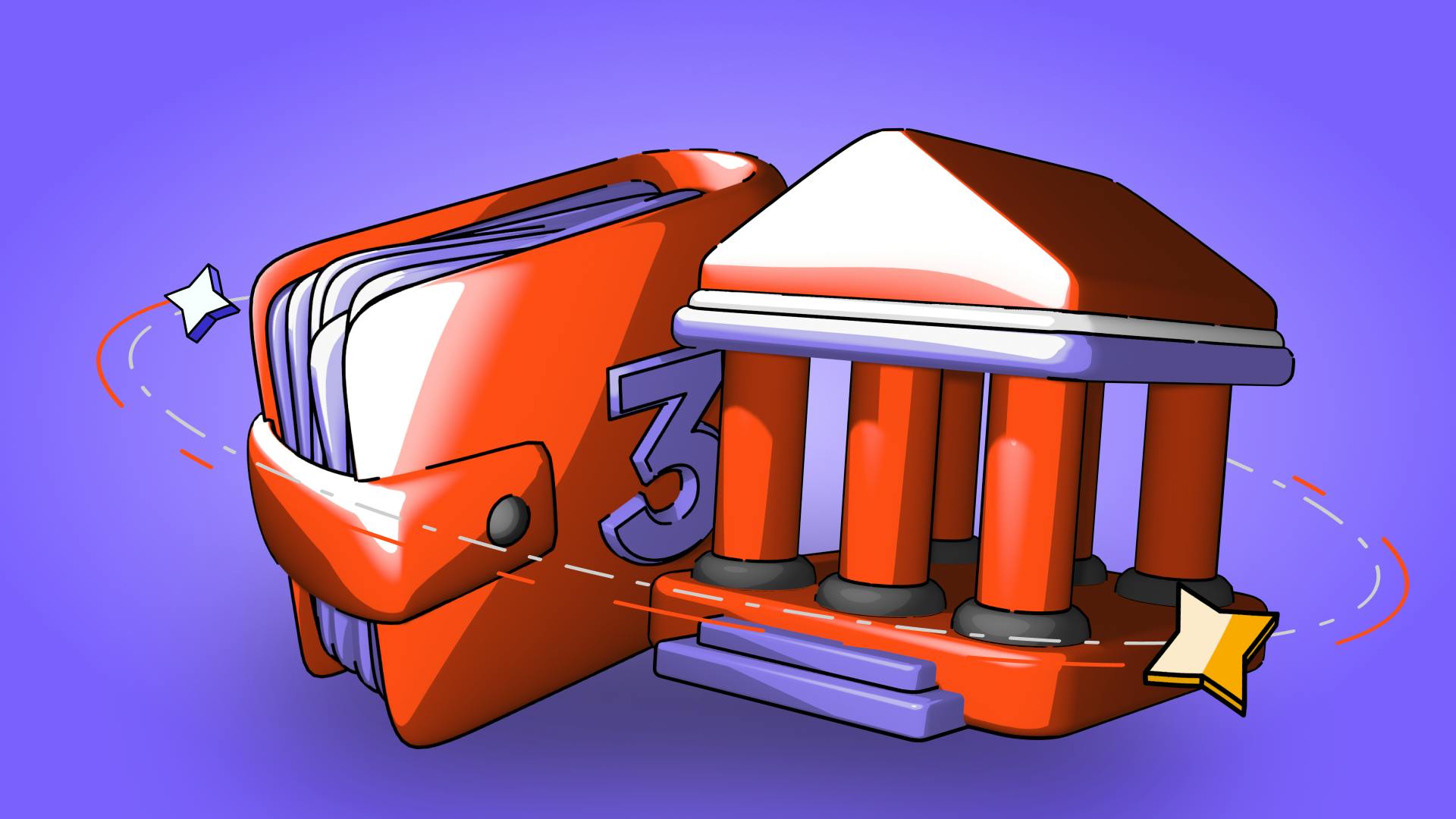Decentralized Finance (DeFi) vs. Traditional Finance: A Comparative Analysis
December 5, 2025

by Coinmetro Editorial Team
December 5, 2025
Decentralized finance (DeFi) has grown rapidly in the past five years, moving billions in transactions. DeFi aims to challenge the monopoly of banks and traditional financial institutions. But how does DeFi stack up against these giants?
DeFi uses blockchain technology and smart contracts to allow direct, peer-to-peer transactions. This eliminates the need for intermediaries, reducing costs and delays. Users can trade, lend, and borrow assets without relying on a central authority, creating a more open financial system. DeFi also offers transparency, as all transactions are recorded on a public ledger, allowing users to track their funds in real-time.
Traditional finance, by contrast, relies on centralized control. Banks, credit unions, and other financial institutions manage transactions and provide services like loans, deposits, and investment management. These systems offer security and consumer protection but come with higher fees and slower processes. Regulations often add complexity, slowing innovation but reducing risk.
This article will compare DeFi and traditional finance across key areas like accessibility, control, transparency, costs, innovation, and risk. By examining these aspects, we aim to provide a clear understanding of their strengths, weaknesses, and roles in the evolving financial landscape.
Here's what this blog will cover:
- Overview of Decentralized Finance (DeFi)
- Overview of Traditional Finance
- Key differences between DeFi and traditional finance
- Benefits and risks
- Case studies
Discover The Growth of DeFi: Notable Platforms and Their Contributions
DeFi, or decentralized finance, is a financial system built on blockchain technology. It removes the need for banks and other middlemen. DeFi uses smart contracts — self-executing code that enforces agreements directly between users. This cuts costs, speeds up transactions, and puts users in full control of their funds.
Blockchain Technology: A decentralized digital ledger that records all transactions across a network of computers. This ensures transparency, security, and immutability of data.
Decentralized Applications (dApps): Applications that run on a blockchain network, allowing users to interact with DeFi services without intermediaries.
Smart Contracts: Automated, self-executing contracts with the terms of the agreement directly written into lines of code. They run on blockchain networks like Ethereum, Solana, Polygon, Avalanche, and Cardano.
Decentralization: DeFi platforms operate on decentralized networks, removing the need for a central authority or intermediary. This decentralization is achieved through blockchain technology, which distributes data across a large network of computers.
Transparency: All transactions and smart contract code are publicly accessible on the blockchain. This transparency allows users to verify and audit transactions independently, fostering trust and security.
Accessibility: DeFi services are accessible to anyone with an internet connection and a compatible digital wallet. This inclusivity eliminates barriers to entry often found in traditional finance, such as geographic restrictions and the need for a bank account.
Decentralized Exchanges (DEXs): These platforms allow users to trade cryptocurrencies directly without the need for an intermediary. DEXs use smart contracts to facilitate trades, potentially providing greater security and lower fees than centralized exchanges. Examples include Uniswap, SushiSwap, and others.
Lending and Borrowing Platforms: DeFi platforms like Aave and Compound enable users to lend their cryptocurrencies to others and earn interest, or to borrow funds by using their crypto assets as collateral. This peer-to-peer lending system operates without traditional credit checks and banking intermediaries.
Yield Farming and Staking: Yield farming involves providing liquidity to DeFi platforms and earning rewards in the form of interest or additional tokens. Staking, on the other hand, involves holding a cryptocurrency in a wallet to support the operations of a proof-of-stake blockchain network and earning rewards. Platforms like Yearn.Finance and Stargate Finance offer these services, allowing users to maximize their returns on crypto holdings.
Discover Passive Income in Crypto: Staking, Lending, and Yield Farming

Traditional finance is the system where money moves through banks, stock exchanges, and insurers. It has shaped the global economy for centuries. It provides structure, clear rules, and stability for financial transactions.
Banks: Offer a wide range of services, including savings accounts, loans, and payment processing.
Stock Exchanges: Platforms where stocks, bonds, and other securities are bought and sold.
Insurance Companies: Provide risk management services through insurance policies.
Credit Unions: Member-owned financial cooperatives offering similar services to banks.
Fintech Apps: Modern financial technology applications that offer banking services, investment options, and payment solutions through user-friendly mobile platforms.
Centralization: Traditional finance relies on centralized institutions like banks, stock exchanges, and insurers. They act as intermediaries, managing financial transactions.
Regulation and Oversight: Governments and regulators enforce strict rules. These rules aim to protect consumers, keep markets stable, and ensure fairness. Examples include the Federal Reserve (USA), SEC (USA), FCA (UK), and ECB (EU).
Established Infrastructure: Traditional finance has a vast network. It includes physical branches, ATMs, and professional services. This structure supports finance but leaves many people underbanked or unbanked.
Savings and Checking Accounts: These accounts allow individuals to deposit money, earn interest (in the case of savings accounts), and access funds through checks, debit cards, and online banking.
Loans and Mortgages: Banks and credit unions provide loans for various purposes, such as personal loans, auto loans, and mortgages for purchasing homes. These loans are typically secured by collateral and come with fixed or variable interest rates.
Investment Services: Traditional finance offers a range of investment options, including stocks, bonds, mutual funds, and retirement accounts like 401(k) plans. Financial advisors and brokers assist individuals in managing their investment portfolios.
Insurance Services: Insurance companies offer products to manage risk, such as life insurance, health insurance, and property insurance. These services provide financial protection against unforeseen events and damages.
Payment Processing: Banks facilitate payment processing services, including wire transfers, electronic funds transfers (EFT), and credit card transactions. These services are essential for both personal and business financial activities.
Check Out this Beginner's Guide to DeFi Lending and Borrowing
DeFi and traditional finance each have unique characteristics. DeFi offers more access, transparency, and innovation. Traditional finance provides stability, regulation, and a proven system.
Accessibility of financial services: DeFi platforms are open to anyone with internet access and a digital wallet. This approach reaches a global audience, including those in areas underserved by banks.
Barriers to entry: Traditional finance often requires complex paperwork, credit checks, and minimum deposits. These steps can exclude many, especially in developing regions. DeFi removes these barriers, making financial services more inclusive.
Decentralized control vs. centralized control: DeFi uses a decentralized model. No single entity controls the system. Instead, control is shared across a network. Traditional finance relies on banks and regulators to manage financial activities.
User ownership of assets in DeFi: In DeFi, users control their assets directly. They can interact with the system without intermediaries. This gives them more control over their funds. In traditional finance, banks and other institutions hold and manage assets, which can limit access.
Transparency in DeFi through Blockchain: DeFi uses public blockchains to record all transactions. This ensures full transparency. Anyone can verify transactions, smart contracts, and system operations. This openness builds trust and reduces the risk of fraud.
Trust in Traditional Finance through Regulation: Traditional finance relies on regulation to build trust. Government bodies set rules to protect consumers and ensure market stability. These rules create a legal framework for financial activities. However, this trust depends on centralized institutions, which can sometimes fail or act against the interests of individuals.
Transaction costs and speed in DeFi: DeFi transactions can be faster and cheaper than those in traditional finance. This is because they cut out intermediaries. However, costs can vary based on blockchain usage and network congestion.
Operational costs and efficiency in traditional finance: Traditional finance generally has higher costs. It relies on physical branches, employees, and other infrastructure. These expenses add to the cost of services. They are often passed on to customers as fees and charges.
Innovation in DeFi: DeFi is known for rapid innovation. Developers can create and launch new financial products without long approval processes. This approach has led to tools like yield farming, liquidity mining, and decentralized lending.
Traditional Finance: Traditional finance is slower to adapt. It faces regulatory limits and a need for stability. While it offers proven financial products, its innovation is limited by strict compliance rules and risk management practices.
Understanding the pros and cons of DeFi and traditional finance helps people make better choices. DeFi offers inclusion, speed, and privacy, but faces regulatory challenges. Traditional finance provides stability and protection, but can lag in innovation.
Financial Inclusion: DeFi platforms offer services to anyone with internet access and a digital wallet. This breaks down barriers and gives underserved groups access to the global financial system.
Reduced Intermediaries: DeFi cuts out banks and brokers. Transactions happen directly between users through smart contracts. This approach reduces fees, speeds up processing, and lowers costs.
Enhanced Privacy: Many DeFi platforms prioritize privacy. Transactions occur without revealing personal information to a central authority. This reduces the risk of identity theft and data breaches.
Security Vulnerabilities: Despite its benefits, DeFi has potential risks. Smart contracts, which power DeFi, can have bugs or weaknesses. Hackers can exploit these flaws, leading to significant financial losses. In the past, high-profile hacks have exposed such risks.
Regulatory Uncertainty: DeFi operates in a changing regulatory landscape. Governments and regulators are still figuring out how to manage this new sector. Future regulations could impact how DeFi platforms work and their legality.
Market Volatility: DeFi markets are highly volatile. Asset prices can change rapidly, creating risks for users. This volatility can lead to significant losses, especially for those who lack market experience.
Stability and Reliability: Traditional finance has a long history of stability. It provides reliable services and operates within clear, established rules. These rules ensure steady performance and protect consumers.
Consumer Protections: Regulators set strict rules to protect consumers. These rules require financial institutions to act in their clients' best interests. They also offer ways to recover losses in cases of fraud or misconduct.
Insurance and Guarantees: Traditional finance provides insurance to protect assets. This includes deposit insurance for bank accounts and investment protection schemes. These programs create a safety net against losses.
Centralization Risks: Traditional finance relies on centralized institutions. If a major institution fails, it can disrupt the entire system. This can lead to widespread financial problems.
Limited Access for Underserved Populations: Traditional finance often struggles to reach underserved groups. High fees, strict requirements, and limited branch networks can exclude many people from financial services.
Slower Innovation: Strict rules and a focus on stability can slow innovation in traditional finance. This cautious approach can delay the use of new financial technologies.
The success of DeFi projects like Uniswap, Aave, and Compound shows the potential of decentralized finance. Traditional finance is starting to adopt these ideas, blending the best of both worlds. This approach can create a more unified, inclusive, and efficient financial system.
Curve Finance (CRV): A decentralized exchange (DEX) designed primarily for stablecoin trading. It uses an automated market maker (AMM) to manage liquidity pools, allowing users to trade stablecoins like DAI, USDC, and USDT with minimal slippage and low fees. Curve's governance token, CRV, enables users to vote on various proposals and earn rewards for providing liquidity.
Compound (COMP): A protocol on the Ethereum blockchain that establishes money markets with algorithmically derived interest rates. Users can lend and borrow cryptocurrencies without intermediaries. The platform's native token, COMP, allows holders to participate in governance and earn rewards by lending or borrowing assets on the network.
Celo (CELO): Celo is a mobile-first blockchain network that aims to bring decentralized finance to smartphone users globally. It features localized stablecoins like cUSD, cEUR, and cREAL, making crypto transactions as easy as sending a text message. Celo's DeFi ecosystem includes projects like Ubeswap and Moola Market, which enhance liquidity and provide yield opportunities.
Perpetual Protocol (PERP): A decentralized platform for trading perpetual contracts, offering trustless and efficient derivative trading. It integrates seamlessly with other DeFi technologies, providing traders with tools to leverage and hedge their positions.
Stargate Finance (STG): Focuses on cross-chain transactions, providing a unified liquidity pool that simplifies asset transfers across different blockchains. It uses a unique lock+mint and burn+redeem mechanism to ensure instant and secure cross-chain transfers, enhancing liquidity and offering yield farming opportunities through its native token, STG.
JPMorgan Chase: JPMorgan Chase has explored blockchain through Quorum, a permissioned blockchain platform. Quorum uses Ethereum’s technology to create a secure way for institutions to manage transactions. It is not fully decentralized, but it shows how traditional finance can use blockchain to improve efficiency.
Santander: The Spanish giant has integrated blockchain to improve its services. The bank uses blockchain for faster, more transparent cross-border payments through its Santander One Pay FX system. This approach combines the speed of blockchain with the security of traditional banking.
Goldman Sachs: Goldman Sachs is exploring DeFi and blockchain. It plans to offer digital assets and is looking into building a digital asset platform. This move shows its interest in the potential of decentralized finance.
Decentralized Finance (DeFi): Utilizes blockchain technology and smart contracts to offer financial services without intermediaries, promoting accessibility, transparency, and rapid innovation.
Traditional Finance: Operates through centralized institutions like banks and stock exchanges, providing stability, regulatory oversight, and consumer protection.
Key Differences: DeFi excels in accessibility and innovation but faces risks like security vulnerabilities and regulatory uncertainty. Traditional finance offers reliability and protection, but is slower to innovate and less inclusive.
DeFi and traditional finance each have strengths and weaknesses. DeFi can drive financial inclusion and innovation, but it faces security and regulatory challenges. Traditional finance offers stability and protection, but must adapt to stay relevant in a changing world.
The future of finance will likely blend DeFi and traditional finance. Hybrid models will combine DeFi's innovation and inclusion with the stability of traditional finance. This approach can create a more inclusive, efficient, and resilient financial system.
▶️ Watch: Decentralized Finance vs. Centralized (DeFi vs. CeFi)
Join the Coinmetro community on Discord and Telegram, where forward-thinking traders and investors gather to share insights, explore new opportunities, and dive deep into cryptocurrencies. Should you need any help, please contact our world-class Customer Support Team via 24/7 live chat or email at hello@coinmetro.com.
To become a Coinmetro user today, Sign Up now, or head to our new Exchange if you are already registered to experience our premium trading platform.
Tags
Related Articles

Regulatory Sandboxes: Fostering Crypto Innovation Within Legal Frameworks
The cryptocurrency industry’s fast rise fuels an important debate. Innovation aims to transform finance, enhancing speed and access. Yet, regulators…
5m

Crypto Options Trading: Strategies and Market Insights
Cryptocurrency markets have rapidly expanded beyond simple buying and selling. One of the most significant developments has been the rise of…
6m

The Rise of Social-Fi: Blending Social Media with Decentralized Finance
In recent years, social media and finance have started to merge, creating Social-Fi. This concept blends the engagement of social platforms with…
6m

DeFi Insurance Platforms to Watch in 2024
Decentralized Finance (DeFi) insurance addresses the growing need for insurance against hacks, smart contract failures, and other DeFi-related risks.…
7m